Study on Soil Water and Heat Transport Characteristic Responses to Land Use Change in Sanjiang Plain
Abstract
1. Introduction
2. Materials and Methods
2.1. Study Area
2.2. Methods
2.2.1. Field Observation Method
2.2.2. Model
2.2.3. Simulation Accuracy Analysis
3. Results and Discussion
3.1. Variation Law of Soil Temperature and Humidity in Different Land Use Modes
3.2. Modeling Analysis
3.2.1. Modeling Simulation Accuracy Analysis
3.2.2. Soil Temperature
3.2.3. Soil Water Content
3.2.4. Soil Water and Heat Flux
3.2.5. Changes in Soil Water and Heat Flux Under Future Climate Change Scenarios
4. Conclusions
Author Contributions
Funding
Conflicts of Interest
References
- Jiang, Y.; Wu, H. Simulation capabilities of 20 CMIP5 models for annual mean air temperatures in Central Asia. Progress. Inquis. Mutat. Clim. 2013, 9, 110–116. [Google Scholar]
- Reinman, S.L. Intergovernmental Panel on Climate Change (IPCC). Encycl. Energy Nat. Resour. Environ. Econ. 2013, 26, 48–56. [Google Scholar]
- Park, H.; Kim, Y.; Kimball, J.S. Widespread permafrost vulnerability and soil active layer increases over the high northern latitudes inferred from satellite remote sensing and process model assessments. Remote Sens. Environ. 2016, 175, 349–358. [Google Scholar] [CrossRef]
- Luo, D.; Wu, Q.; Jin, H.; Marchenko, S.S.; Lu, L.; Gao, S. Recent changes in the active layer thickness across the northern hemisphere. Environ. Earth Sci. 2016, 75, 555. [Google Scholar] [CrossRef]
- Peng, X.; Mu, C. Changes of soil thermal and hydraulic regimes in the Heihe River Basin. Environ. Monit. Assess. 2017, 189, 483. [Google Scholar] [CrossRef] [PubMed]
- Bense, V.F.; Kooi, H.; Ferguson, G.; Read, T. Permafrost degradation as a control on hydrogeological regime shifts in a warming climate. J. Geophys. Res. Earth Surf. 2012, 117. [Google Scholar] [CrossRef]
- Cheng, G.; Jin, H. Permafrost and groundwater on the Qinghai-Tibet Plateau and in northeast China. Hydrogeol. J. 2013, 21, 5–23. [Google Scholar] [CrossRef]
- Ford, T.W.; Frauenfeld, O.W. Surface-atmosphere moisture interactions in the frozen ground regions of Eurasia. Sci. Rep. 2016, 6, 19163. [Google Scholar] [CrossRef]
- Li, S.; Lai, Y.; Pei, W.; Zhang, S.; Zhong, H. Moisture–temperature changes and freeze–thaw hazards on a canal in seasonally frozen regions. Nat. Hazards 2014, 72, 287–308. [Google Scholar] [CrossRef]
- Weiqiang, L.; Lei, Y.; Zhang, X.; Tian, K. Study of water and salt migration in soil under concrete mulch during freezing/thawing period. J. Glaciol. Geocryol. 2001, 3. [Google Scholar]
- Zheng, X.; Fan, G. Influence of moisture content on infiltration characteristics in seasonal frozen and thawed soils. Trans. CSAE 2000, 16, 52–55. [Google Scholar]
- Qiang, F.; Renije, H.; Zilong, W.; Tianxiao, L.; Xianghao, W. Soil thermal regime under snow cover and its response to Meteorological factor. Trans. Chin. Soc. Agric. Mach 2015, 46, 154–161. [Google Scholar]
- Rui, J.; Xin, L. Improving the estimation of hydrothermal state variables in the active layer of frozen ground by assimilating in situ observations and SSM/I data. Sci. China 2009, 52, 1732–1745. [Google Scholar]
- Qiang, F.; Renije, H.; Tianxiao, L.; Ziao, M.; Li, P. Soil moisture-heat transfer and its action mechanism of freezing and thawing soil. Trans. Chin. Soc. Agric. Mach. 2016, 47, 99–110. [Google Scholar]
- Hirsch, A.L.; Guillod, B.P.; Seneviratne, S.I.; Beyerle, U.; Boysen, L.R.; Brovkin, V.; Davin, E.L.; Doelman, J.C.; Kim, H.; Mitchell, D.M.; et al. Biogeophysical impacts of land-use change on climate extremes in low-emission scenarios: Results from HAPPI-land. Earths Future 2018, 6, 396–409. [Google Scholar] [CrossRef] [PubMed]
- Zhai Jun, S.Q.; Liu, J. Impact analysis of climate change from land use/cover change in inner Mongolia Plateau. J. Nat. Resour. 2014, 29, 967–978. [Google Scholar]
- Song, K.; Liu, D.; Wang, Z.; Zhang, B.; Jin, C.; Li, F.; Liu, H. Land use change in Sanjiang Plain and its driving forces analysis since 1954. Acta Geogr. Sin. 2008, 63, 93–104. [Google Scholar]
- Zhang, K. Impacts of Wetland Sucession on Soil Freezing and Thawing Process and Heat Exchange in Sanjiang Plain; University of Chinese Academy of Sciences: Huairou, China, 2011. [Google Scholar]
- Lian, J.; Wang, J.; Zeng, H. Impacts of dramatic land use change on the near-surface air temperature in Shenzhen. Acta Sci. Nat. Univ. Pekin. 2017, 53, 692–700. [Google Scholar]
- Ding, Q. Assessing the Impact of Land Use/Cover Change on Water and Heat Fluxes—A Case Applied GIS Study of Jiangxi Province; Shandong Normal University: Jinan, China, 2013. [Google Scholar]
- Song, C.; Yan, B.; Wang, Y.; Zhao, Z.; Lou, Y. Effect of mires reclamation on soil moisture, temperature and characters. J. Soil Water Conserv. 2003, 6, 144–147. [Google Scholar]
- Song, C.C.; Wang, Y.Y.; Yan, B.X.; Lou, Y.J.; Zhao, Z.C. The changes of the soil hydrothermal condition and the dynamics of C, N after the Mire Tillage. Environ. Sci. 2004, 25, 150–154. [Google Scholar]
- Song, C.; Wang, Y.; Yan, B.; Zhang, J.; Lou, Y. Variation of soil temperature before and after cultivation of marsh and its effect on soil thermal regime. Chin. J. Appl. Ecol. 2005, 16, 88–92. [Google Scholar]
- Zhang, L. Study on the Change of Cultivated Land Use under the Background of Climate Change in Sanjiang Plain. Master’s Thesis, Northeast Agricultural University, Harbin, China, 2017. [Google Scholar]
- Flerchinger, G.N. Sensitivity of soil freezing simulated by the SHAW model. Trans. ASAE 1991, 34, 2381–2389. [Google Scholar] [CrossRef]
- Flerchinger, G.N.; Saxton, K.E. Simultaneous heat and water model of a freezing snow-residue-soil System I. Theory and development. Trans. ASAE 1989, 32, 565–571. [Google Scholar] [CrossRef]
- Flerchinger, G.N.; Kustas, W.P.; Weltz, M.A. Simulating surface energy fluxes and radiometric surface temperatures for two arid vegetation communities using the SHAW model. J. Appl. Meteorol. 1998, 37, 449–460. [Google Scholar] [CrossRef]
- Link, T.E.; Unsworth, M.H.; Marks, D.G.; Flerchinger, G.N. Simulation of water and energy fluxes in an old growth seasonal temperate rainforest using the simultaneous heat and water (SHAW) model. J. Hydrometeorol. 2004, 5, 443–457. [Google Scholar] [CrossRef]
- Nash, J.E.; Sutcliffe, J.V. River flow forecasting through conceptual models part I—A discussion of principles. J. Hydrol. 1970, 10, 282–290. [Google Scholar] [CrossRef]
- Guo, D.; Yang, M. Simulation of soil temperature and moisture in seasonally frozen ground of Central Tibetan Plateau by SHAW model. Plateau Meteorol. 2010, 29, 1369–1377. [Google Scholar]
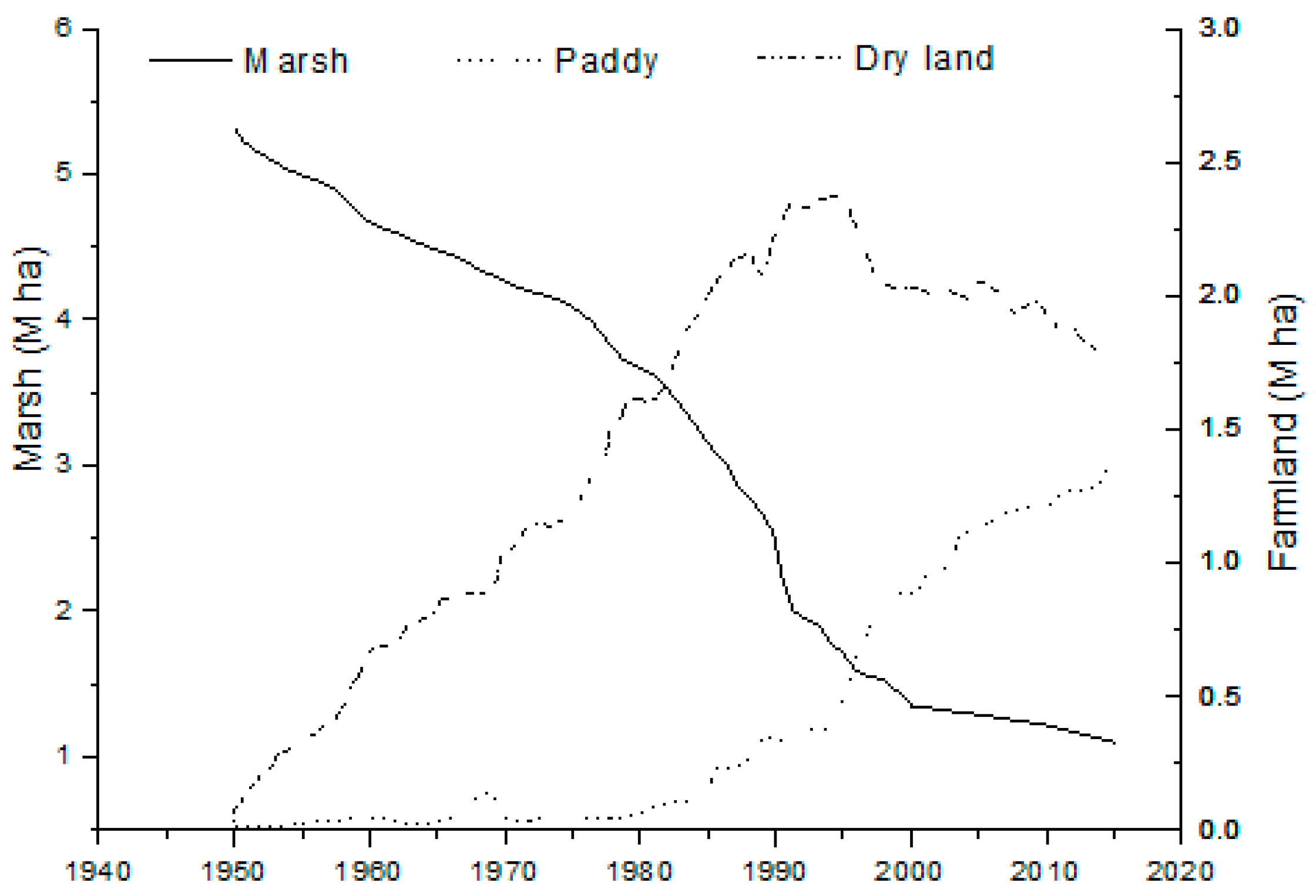
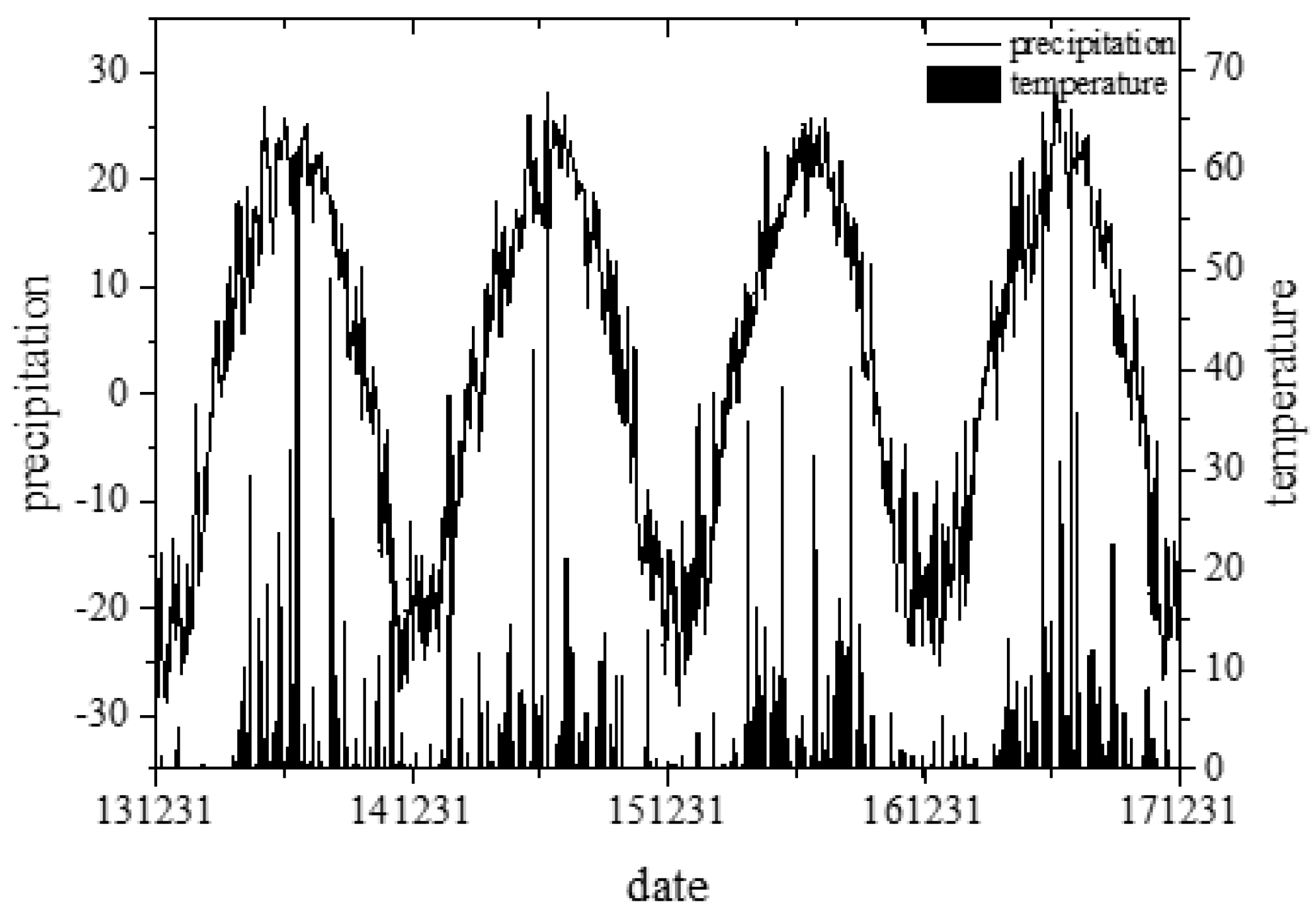
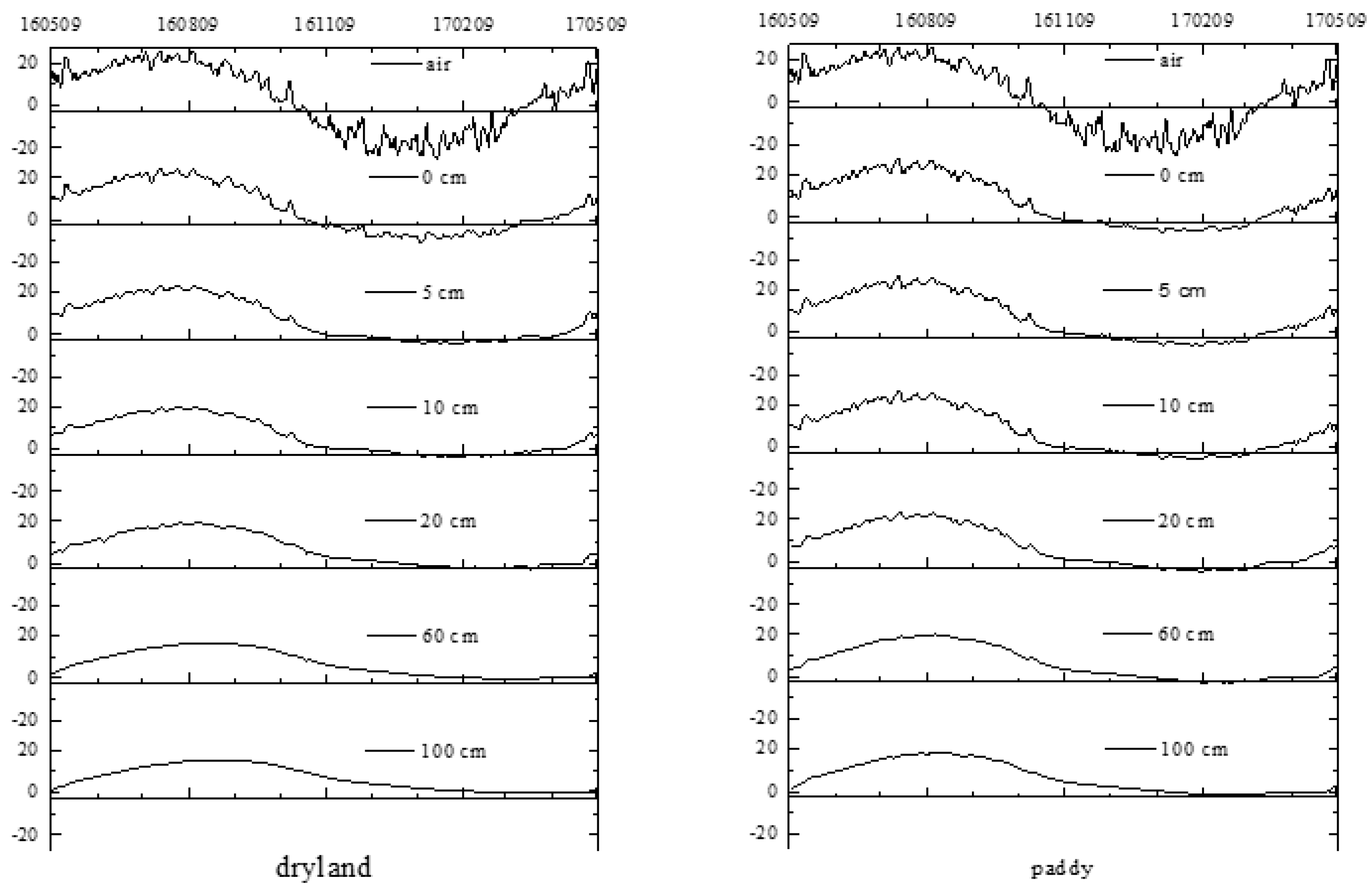
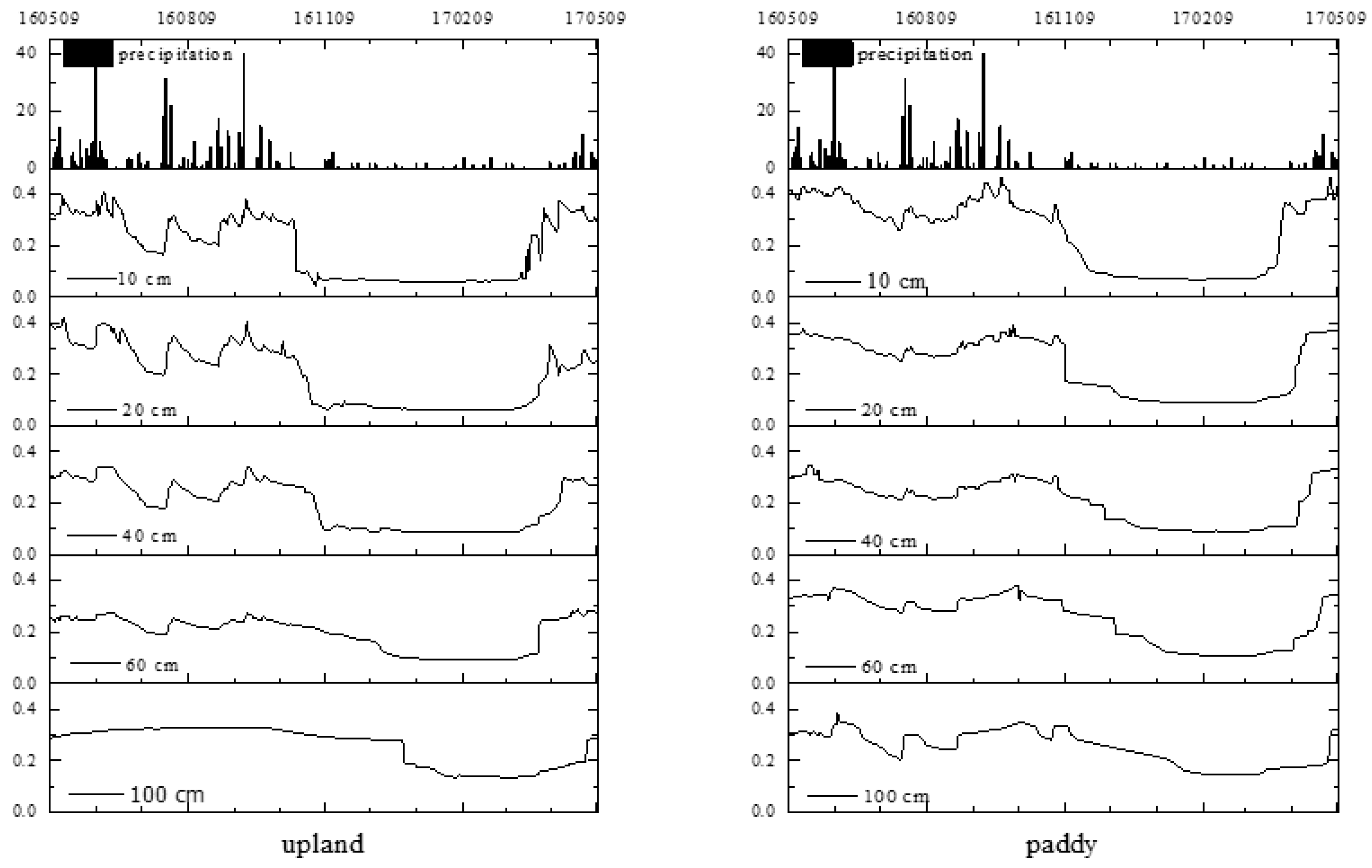




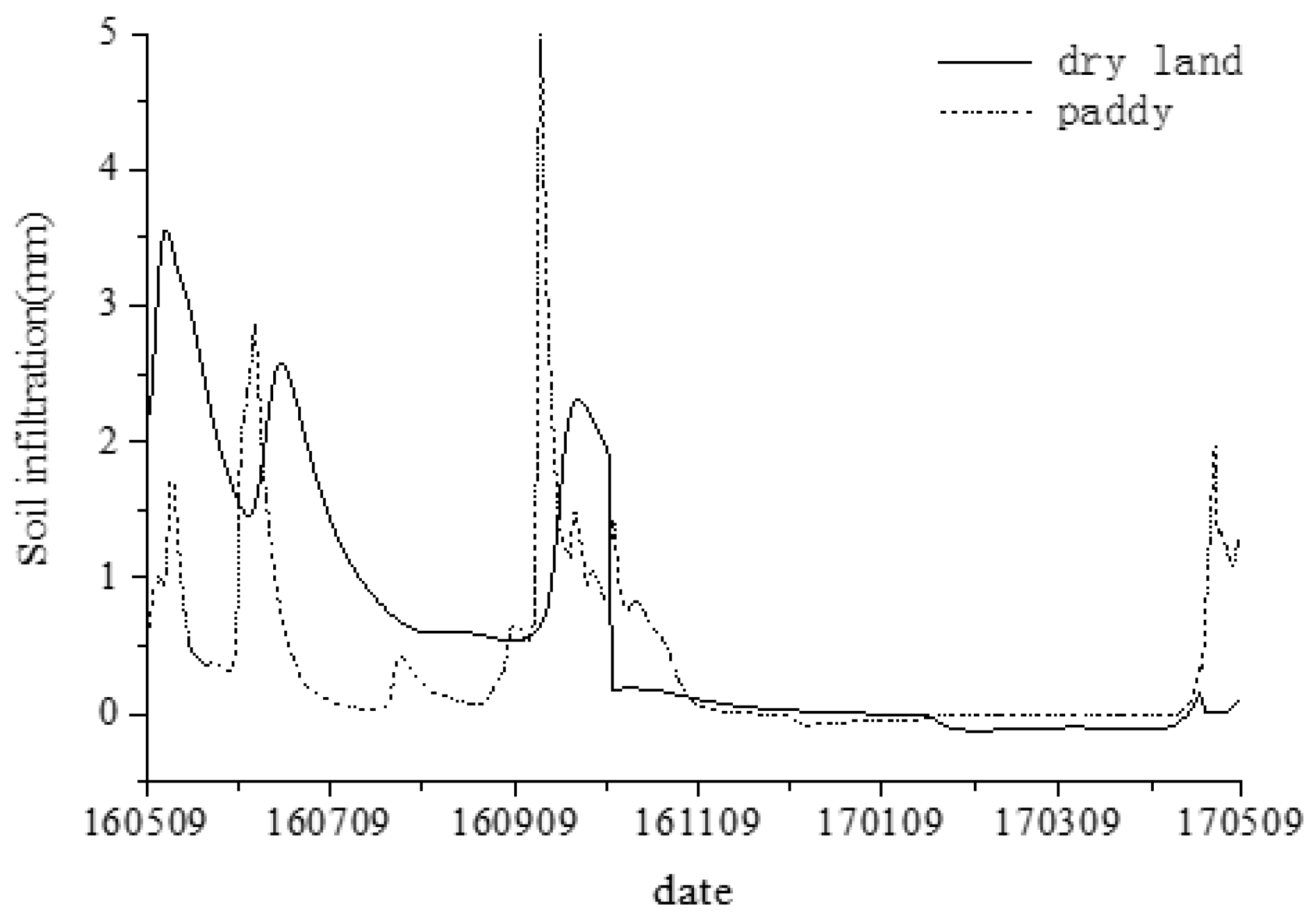
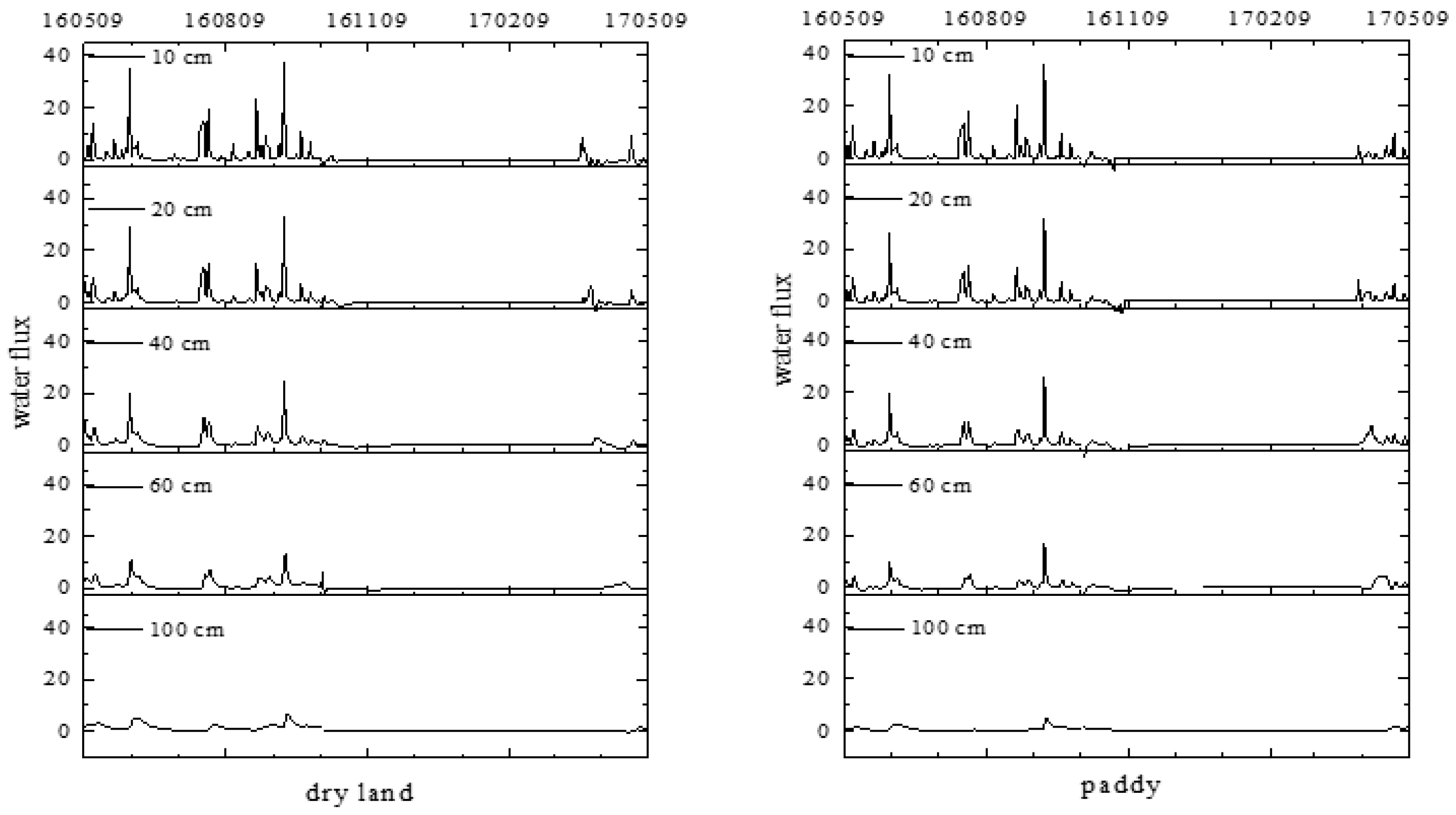
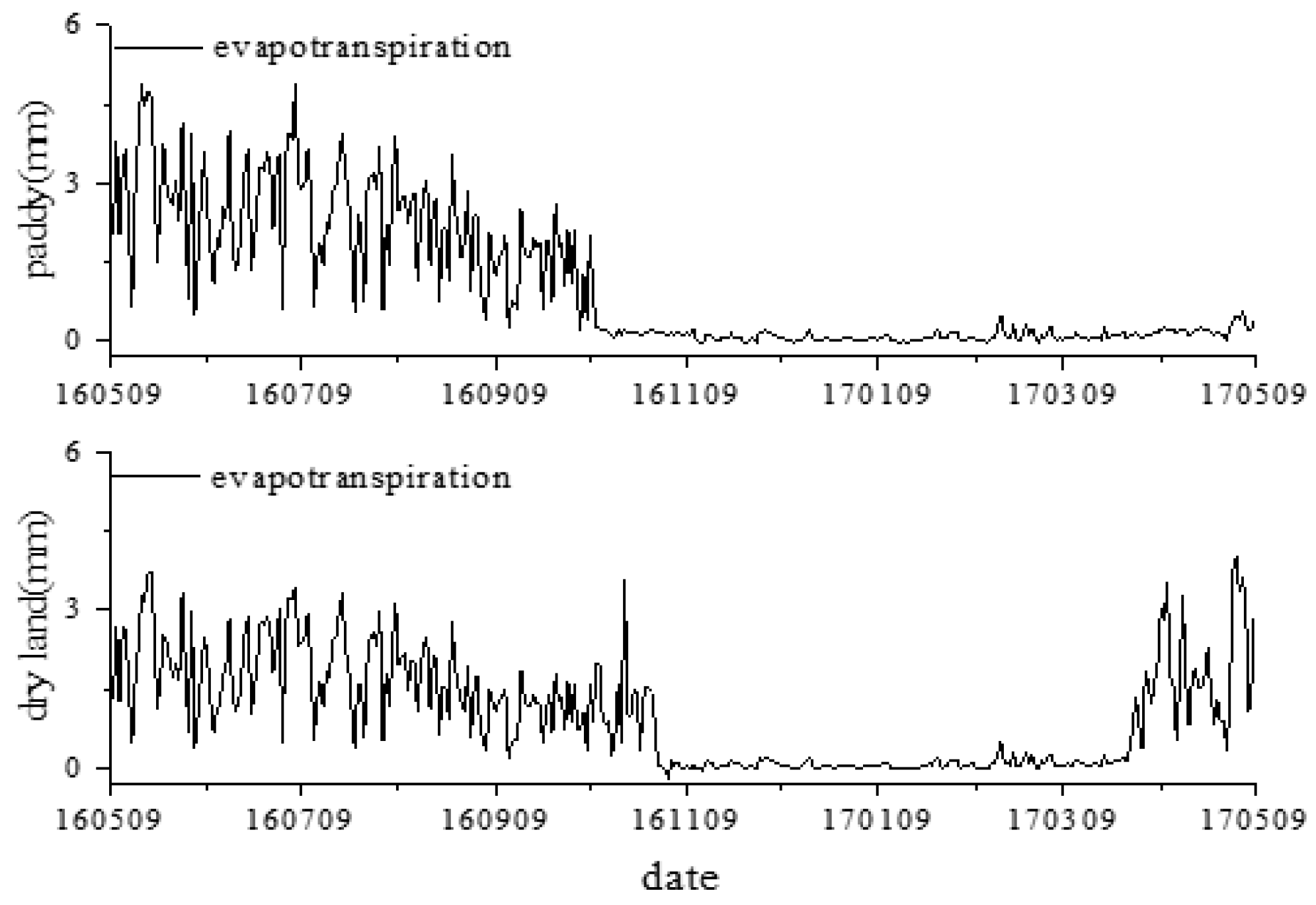
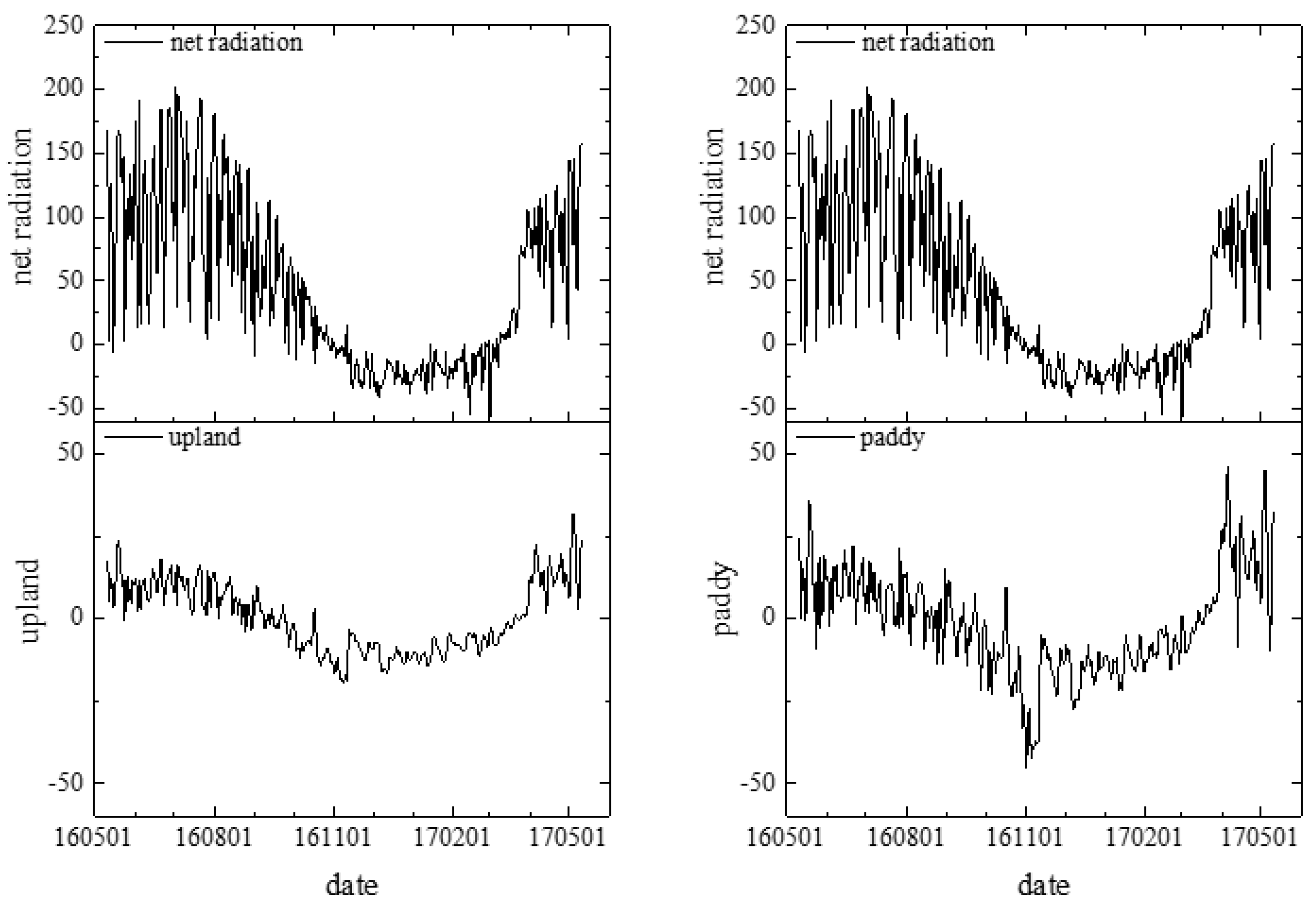
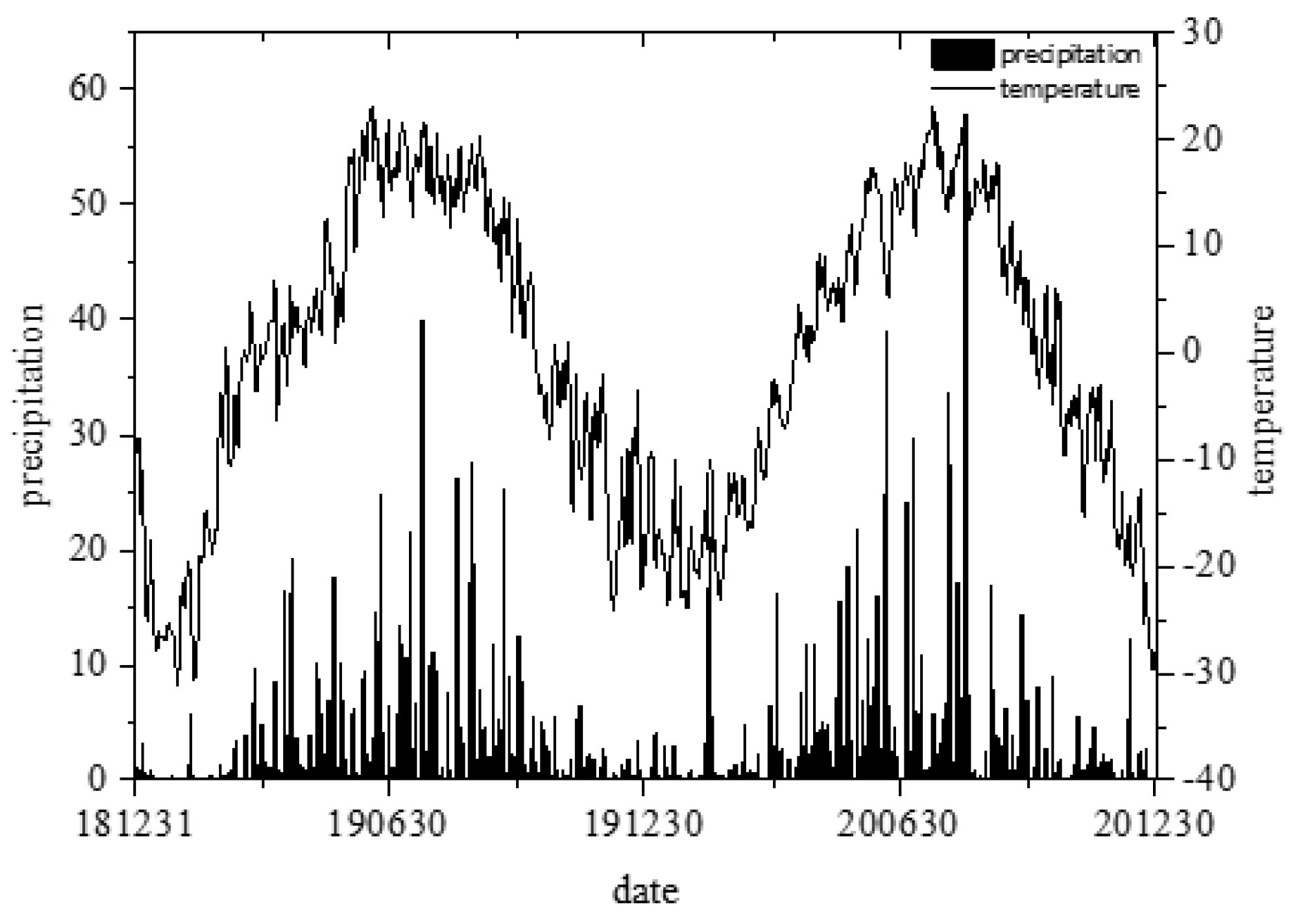
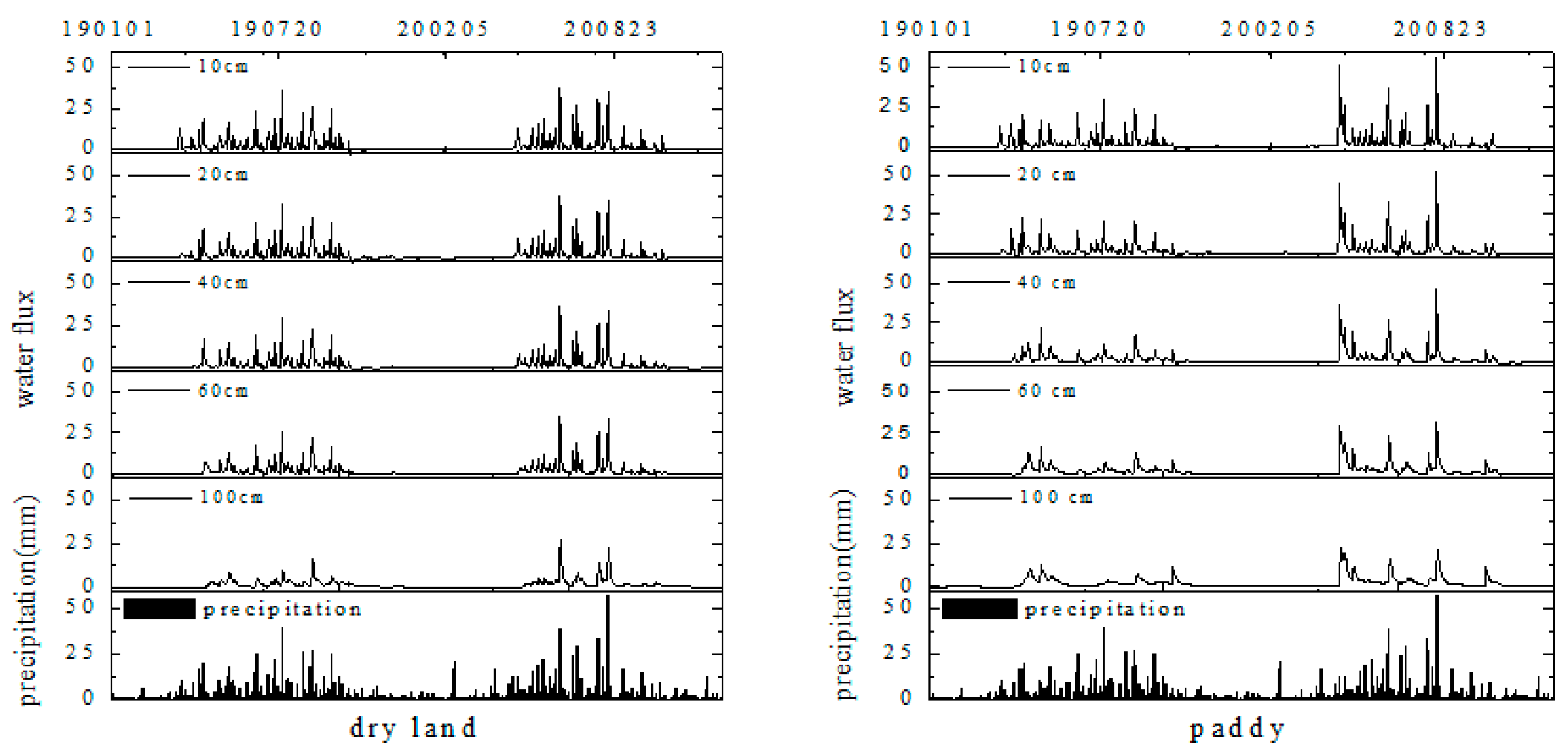
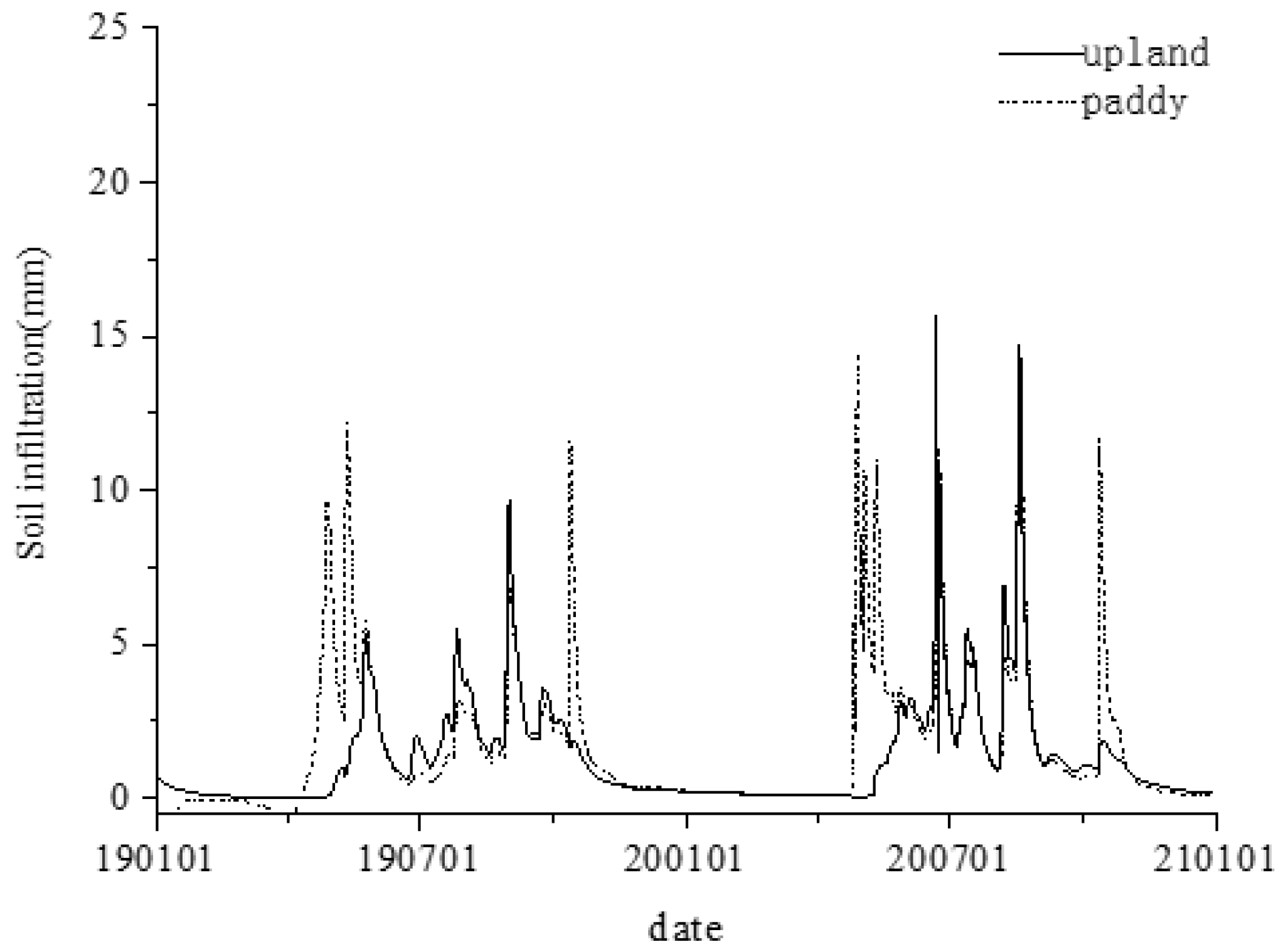
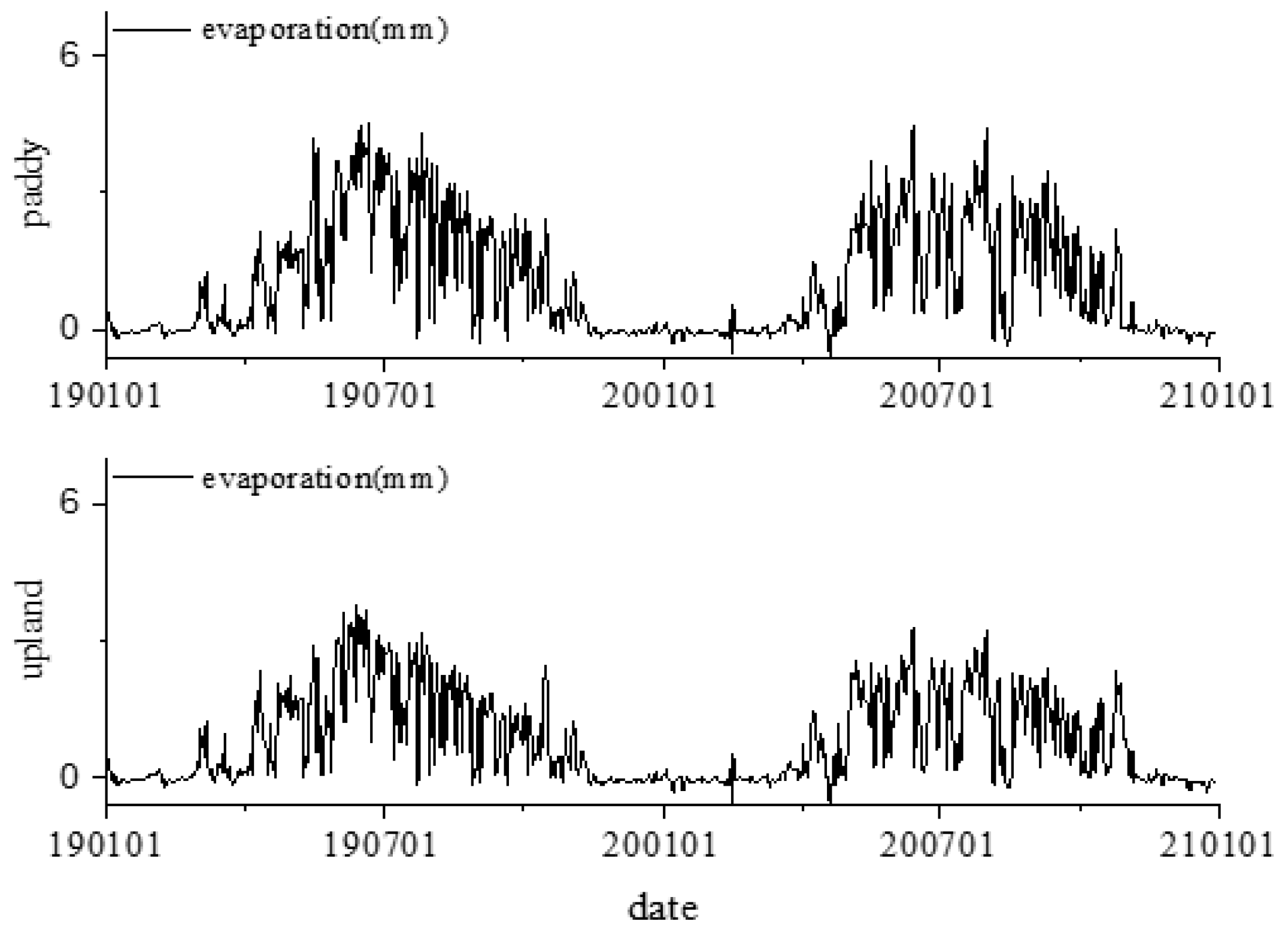
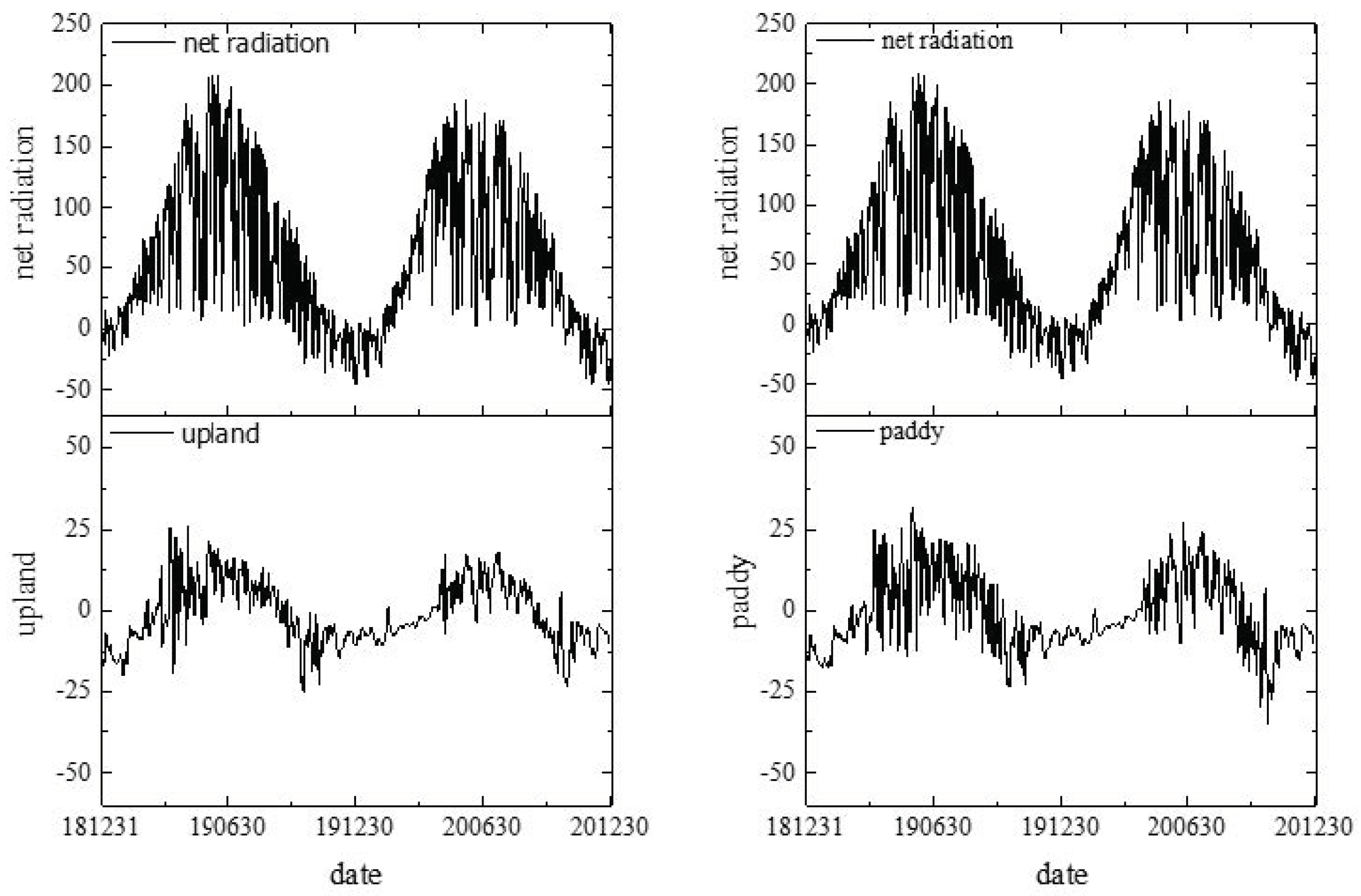
| Depth/cm | 10 | 20 | 40 | 60 | 80 | 100 | 120 | 150 | |
|---|---|---|---|---|---|---|---|---|---|
| Bulk density | Dry land | 1.23 | 1.26 | 1.43 | 1.44 | 1.32 | 1.3 | 1.32 | 1.32 |
| Paddy | 1.23 | 1.26 | 1.43 | 1.44 | 1.32 | 1.3 | 1.32 | 1.32 | |
| Saturated water content | Dry land | 0.513 | 0.513 | 0.5 | 0.5 | 0.5 | 0.5 | 0.5 | 0.5 |
| Paddy | 0.513 | 0.513 | 0.5 | 0.5 | 0.5 | 0.5 | 0.5 | 0.5 | |
| Saturated conductivity (cm/h) | Dry land | 1 | 1 | 1 | 1 | 0.68 | 0.6 | 0.37 | 0.37 |
| Paddy | 1 | 1 | 1 | 1 | 0.68 | 0.6 | 0.37 | 0.37 |
| Depth/cm | Upland | Paddy | |||||||
|---|---|---|---|---|---|---|---|---|---|
| ME/% | RMSE | MBE | RMAE | ME/% | RMSE | MBE | RMAE | ||
| Temperature | 0 | 95.1 | 1.01 | 0.48 | 0.05 | 83.3 | 1.98 | 1.48 | 0.09 |
| 5 | 96.3 | 0.83 | 0.59 | 0.04 | 88.4 | 1.55 | 0.93 | 0.08 | |
| 10 | 99.5 | 0.26 | −0.05 | 0.01 | 90.5 | 1.37 | 0.63 | 0.08 | |
| 15 | 97.6 | 0.63 | −0.11 | 0.04 | 91.6 | 1.27 | 0.43 | 0.07 | |
| 20 | 98.2 | 0.52 | −0.15 | 0.04 | 90.4 | 1.31 | −0.03 | 0.07 | |
| 40 | 98.6 | 0.43 | −0.19 | 0.03 | 91.8 | 1.19 | 0.11 | 0.08 | |
| 60 | 95.5 | 0.73 | −0.47 | 0.06 | 99.6 | 0.31 | 0.17 | 0.02 | |
| 100 | 96.9 | 0.56 | 0.47 | 0.06 | 99.8 | 0.20 | 0.19 | 0.02 | |
| Moisture | 0 | 94.8 | 0.010 | 0.004 | 0.02 | 82.6 | 0.020 | −0.003 | 0.029 |
| 5 | 80.5 | 0.014 | 0.004 | 0.02 | 85.9 | 0.016 | 0.001 | 0.024 | |
| 10 | 82.1 | 0.016 | 0.009 | 0.04 | 76.8 | 0.013 | 0.002 | 0.020 | |
| 15 | 98.1 | 0.003 | 0.002 | 0.01 | 93.2 | 0.006 | 0.001 | 0.009 | |
| 20 | 96.3 | 0.002 | 0.004 | 0.04 | 86.4 | 0.009 | −0.002 | 0.007 | |
| 40 | 94.9 | 0.002 | 0.001 | 0.03 | 86.6 | 0.01 | 0.001 | 0.018 | |
| 60 | 85.6 | 0.004 | −0.001 | 0.01 | 84.4 | 0.01 | −0.001 | 0.026 | |
| 100 | 97.9 | 0.001 | 0.001 | 0.07 | 86.8 | 0.01 | −0.003 | 0.023 | |
| Depth/cm | Dry Field Temperature | Paddy Temperature | ||||||
|---|---|---|---|---|---|---|---|---|
| ME/% | RMSE | MBE | RMAE | ME/% | RMSE | MBE | RMAE | |
| 0 | 93 | 2.93 | −1.02 | 0.42 | 96.8 | 1.96 | 0.75 | 0.23 |
| 5 | 99 | 1.07 | 0.25 | 0.12 | 97.8 | 1.54 | 0.66 | 0.18 |
| 10 | 99 | 1.02 | −0.63 | 0.13 | 97.6 | 1.59 | 0.78 | 0.18 |
| 15 | 99 | 0.64 | 0.2 | 0.07 | 97.9 | 1.42 | 0.79 | 0.16 |
| 20 | 98 | 1.12 | 0.02 | 0.15 | 97.9 | 1.33 | 0.59 | 0.15 |
| 40 | 98 | 0.86 | 0.2 | 0.11 | 98.8 | 0.93 | 0.35 | 0.1 |
| 60 | 98 | 0.78 | 0.16 | 0.1 | 99 | 0.77 | 0.17 | 0.08 |
| 100 | 100 | 0.29 | −0.01 | 0.03 | 99.6 | 0.45 | 0.07 | 0.04 |
| Depth/cm | Dry Field Moisture | Depth/cm | Paddy Moisture | ||||||
|---|---|---|---|---|---|---|---|---|---|
| ME/% | RMSE | MBE | RMAE | ME/% | RMSE | MBE | RMAE | ||
| 0 | 82.2 | 0.05 | 0.007 | 0.15 | 0 | 80 | 0.05 | −0.017 | 0.19 |
| 5 | 91.4 | 0.03 | 0.007 | 0.09 | 5 | 86.2 | 0.05 | −0.013 | 0.16 |
| 10 | 87.6 | 0.03 | 0.005 | 0.1 | 10 | 90 | 0.04 | 0.018 | 0.1 |
| 15 | 78.7 | 0.03 | −0.009 | 0.11 | 15 | 83.6 | 0.05 | 0.025 | 0.11 |
| 20 | 90.8 | 0.02 | 0.014 | 0.07 | 20 | 91.5 | 0.03 | −0.017 | 0.11 |
| 40 | 90.6 | 0.02 | 0.001 | 0.06 | 40 | 90.8 | 0.03 | −0.005 | 0.09 |
| 60 | 79 | 0.02 | 0.008 | 0.06 | 60 | 95 | 0.02 | 0.002 | 0.06 |
| 100 | 85.2 | 0.01 | 0.005 | 0.02 | 100 | 79.6 | 0.03 | 0.005 | 0.09 |
© 2018 by the authors. Licensee MDPI, Basel, Switzerland. This article is an open access article distributed under the terms and conditions of the Creative Commons Attribution (CC BY) license (http://creativecommons.org/licenses/by/4.0/).
Share and Cite
Zuo, Y.; Guo, Y.; Song, C.; Jin, S.; Qiao, T. Study on Soil Water and Heat Transport Characteristic Responses to Land Use Change in Sanjiang Plain. Sustainability 2019, 11, 157. https://doi.org/10.3390/su11010157
Zuo Y, Guo Y, Song C, Jin S, Qiao T. Study on Soil Water and Heat Transport Characteristic Responses to Land Use Change in Sanjiang Plain. Sustainability. 2019; 11(1):157. https://doi.org/10.3390/su11010157
Chicago/Turabian StyleZuo, Yunjiang, Yuedong Guo, Changchun Song, Shaofei Jin, and Tianhua Qiao. 2019. "Study on Soil Water and Heat Transport Characteristic Responses to Land Use Change in Sanjiang Plain" Sustainability 11, no. 1: 157. https://doi.org/10.3390/su11010157
APA StyleZuo, Y., Guo, Y., Song, C., Jin, S., & Qiao, T. (2019). Study on Soil Water and Heat Transport Characteristic Responses to Land Use Change in Sanjiang Plain. Sustainability, 11(1), 157. https://doi.org/10.3390/su11010157






